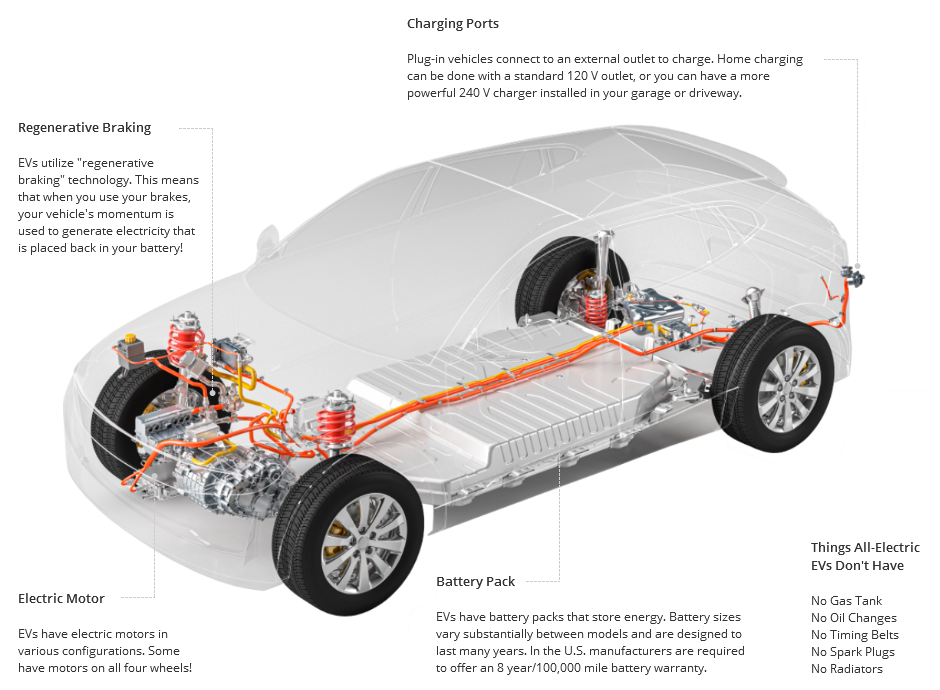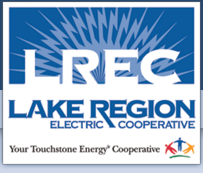EVs are a little different than their gas counterpart.
They have four wheels, a steering wheel and a gas pedal... but the mechanics of an EV are much simpler than gas-powered motors. Here's a look at the key systems that most electric vehicles utilize.


Battery Electric Vehicles
BEV have a battery and an electric motor instead of a gas tank and an internal combustion engine. Sometimes BEVs are also referred to as "All Electric Vehicles" or "Plug-in Vehicles" (not to be confused with Plug-in Hybrid Electric Vehicles). They run entirely on electricity and do not produce any exhaust from the burning of fuel.

Plug-in Hybrid Electric Vehicles
PHEV have an electric motor AND a gas-powered internal combustion engine. Some PHEVs operate exclusively, or almost exclusively, on electricity until the battery is nearly depleted, then the gasoline-powered engine turns on to provide power. Like Battery Electric Vehicles, PHEVs can be plugged in to charge the battery when the vehicle is not in use.

Hybrid Electric Vehicles
HEV have an electric motor AND a gas-powered internal combustion engine, and don't plug-in for charging. HEVs can have substantial range on a single tank of gas, but they still burn fossil fuel, produce carbon emissions, require trips to the gas station and scheduled engine-maintenance. An HEV may be an ideal choice for those with extended commutes and limited charging system access.

Charging your EV requires plugging into a charger connected to the electric grid, also called electric vehicle supply equipment (EVSE). There are three major categories of chargers, based on the amount of power the charger can provide:
AC Level 1
Provides charging through a 120 V AC plug and does not require installation of additional charging equipment. Level 1 can typically deliver two to five miles of range per hour of charging. Level 1 is most often used in home applications, but is sometimes used at workplaces. A full charge may take up to 24 hours with level 1 120 V charging.
AC Level 2
Provides charging through a 240 V plug and requires the installation of additional charging equipment by a qualified electrician/installer. Level-2 chargers typically deliver 10 to 20 miles of range per hour of charging. Level 2 is used in homes, workplaces and for some public charging. Level 2 charging systems provide slight energy efficiency benefits over level 1 chargers - savings estimates vary based on length of charge time.
LEVEL 2 HOME CHARGING OPTIONS
DC Fast-Charge
Provides charging through 480 V AC input and requires specialized, high-powered charging equipment and special equipment in the vehicle itself. DC Fast-Charging can deliver an 80 percent battery charge or 60 to 100 miles of range for most EV models in about 20-30 minutes of charging. This format is used in public charging stations, especially along heavy-traffic corridors. Plug-in hybrid electric vehicles typically do not have fast charging capabilities.
FIND PUBLIC CHARGING NEAR YOU
EV range can be affected by many factors, including driving behavior, terrain, and weather conditions. The following information will help you understand how to optimize EV battery health and performance.
Cold temperatures affect vehicle fuel economy, which can temporarily reduce driving range.1 As the temperature lowers, the chemical and physical reactions in the batteries slow, resulting in short term range reduction.2 Cold temperatures may result in slightly longer charging times and additional energy needs for battery temperature management (technologies vary by EV model). The variable you can control the most is the additional energy used for heating to keep you comfortable on cold days!
Hot temperatures can have a negative impact on vehicle performance and battery health. Storing and charging vehicles during extremely hot temperatures can result in battery degradation.2 Additionally, air conditioning can use significant amounts of energy and will vary based on the air conditioning technology a vehicle utilizes. For example, vehicles utilizing “heat pump” technology may be more efficient than others.
The following temperature-adjusted range estimates were compiled using estimates derived from a study of 5.2 million trips by 4,200 EVs representing 100+ models. This study found that EVs perform optimally, in terms of fuel economy, at 70° F and while both hot and cold temperatures impact range, colder weather has a larger impact. 3
100° F results in 80% to 100% of the estimated average reported range
80° F results in 85% to 100%+
70° F results in 100%+
32° F results in 55% to 85%
20° F results in 45% to 70%
EV drivers should prepare for hot and cold weather by keeping vehicles charged up when not in use, ideally in a garage, where temperatures can be a less extreme. On hot days, it may be best to park in shady locations. Be sure to consult manufacturer guides for information about individual models and best-practices. Lastly, it’s important to note that gas vehicle efficiency is also significantly impacted by driving behavior, terrain, and hot and cold weather conditions.
Electric vehicle batteries are typically designed to last for the expected life of the vehicle, but battery life should be considered when calculating the extended cost of ownership, as all batteries eventually wear out and must be replaced. Battery replacement is typically costly, but keep in mind that gas powered vehicle equipment, such as motors and transmissions, have a lifespan too. The rate at which batteries expire depends on the type of battery and how they are used.
The failure rate of some electric vehicles batteries already on the road is as low as 0.003%4. There are also high mileage warranties on electric vehicle batteries available with many manufacturers. Several manufactures offer multi-year and 100,000 mile+ warranties on the batteries in their vehicles. Review manufacturer information carefully when selecting an EV model.
Emissions
EVs produce no tailpipe emissions. Even when the power is generated using fossil fuels, electric vehicles usually show significant reductions in overall global carbon emissions over gasoline vehicles due to the highly carbon-intensive process of mining, pumping, refining and transporting gasoline.
Energy Efficiency
Internal combustion engines are relatively inefficient at converting fuel energy to propulsion as most of the energy is wasted as heat. Electric motors are more efficient in converting stored energy into propulsion, and electric-drive vehicles do not consume energy while at rest or coasting. Additionally, regenerative braking can be used to re-capture energy during braking. Typically, conventional gasoline engines effectively use only 15 percent of the fuel-energy content to move the vehicle or to power accessories, while electric-drive vehicles have on-board efficiency of around 80 percent5.
Electric cars are not completely environmentally friendly as there can be significant issues to consider related to energy and material use in the manufacturing process. This may include energy-intensive manufacturing processes or the mining and refinement of chemicals and materials.
The average U.S. household spends nearly one-fifth of its total family expenditures on transportation, thus saving on fuel can make a big difference in the average family's budget6. Electricity is less expensive than gasoline and EVs are more efficient than gas-powered vehicles. Electric prices are also generally much more stable than gasoline prices. On a national average, it costs less than half as much to travel the same distance in an EV than a conventional vehicle. Your savings could be far more substantial if your current gas-powered vehicle gets poor mileage.
SAVINGS & CHARGE TIME
Battery Electric Vehicles (or BEV) require less maintenance than conventional vehicles because there are fewer fluids (like oil and transmission fluid) to change, and far fewer moving parts. EVs require minimal scheduled maintenance to their electrical systems, which can include the battery, electrical motor, and associated electronics. Because of regenerative braking, brake systems on EVs typically last longer than on conventional vehicles.
Sources
1 Koncar, I., & Bayram, I. S. (2021). A probabilistic methodology to quantify the impacts of cold weather on electric vehicle demand: A case study in the UK. IEEE Access, 9, 88205-88216.
2 EV Range and Battery Guide. Recurrent Auto. (n.d.). Retrieved from: https://support.recurrentauto.com/hubfs/ev-range-battery-guide.pdf
3 To What Degree Does Temperature Impact EV Range. Geotab. (2023). Retrieved from: https://www.geotab.com/blog/ev-range/
4 U.S. Department of Energy – Energy Efficiency and Renewable Energy Alternative Fuels Data Center, Maintenance and Safety of Hybrid and Plug-In Electric Vehicles.
5 Shah, Saurin D. (2009), Plug-In Electric Vehicles: What Role for Washington? (1st edition). The Brookings Institution. pp. 29, 37 and 43.
6 U.S. Department of Energy – Office of Energy Efficiency and Renewable Energy, Saving on Fuel and Vehicle Costs.

Types of EVs

Battery Electric Vehicles
BEV have a battery and an electric motor instead of a gas tank and an internal combustion engine. Sometimes BEVs are also referred to as "All Electric Vehicles" or "Plug-in Vehicles" (not to be confused with Plug-in Hybrid Electric Vehicles). They run entirely on electricity and do not produce any exhaust from the burning of fuel.

Plug-in Hybrid Electric Vehicles
PHEV have an electric motor AND a gas-powered internal combustion engine. Some PHEVs operate exclusively, or almost exclusively, on electricity until the battery is nearly depleted, then the gasoline-powered engine turns on to provide power. Like Battery Electric Vehicles, PHEVs can be plugged in to charge the battery when the vehicle is not in use.

Hybrid Electric Vehicles
HEV have an electric motor AND a gas-powered internal combustion engine, and don't plug-in for charging. HEVs can have substantial range on a single tank of gas, but they still burn fossil fuel, produce carbon emissions, require trips to the gas station and scheduled engine-maintenance. An HEV may be an ideal choice for those with extended commutes and limited charging system access.
Charging your EV

Charging your EV requires plugging into a charger connected to the electric grid, also called electric vehicle supply equipment (EVSE). There are three major categories of chargers, based on the amount of power the charger can provide:
AC Level 1
Provides charging through a 120 V AC plug and does not require installation of additional charging equipment. Level 1 can typically deliver two to five miles of range per hour of charging. Level 1 is most often used in home applications, but is sometimes used at workplaces. A full charge may take up to 24 hours with level 1 120 V charging.
AC Level 2
Provides charging through a 240 V plug and requires the installation of additional charging equipment by a qualified electrician/installer. Level-2 chargers typically deliver 10 to 20 miles of range per hour of charging. Level 2 is used in homes, workplaces and for some public charging. Level 2 charging systems provide slight energy efficiency benefits over level 1 chargers - savings estimates vary based on length of charge time.
LEVEL 2 HOME CHARGING OPTIONS
DC Fast-Charge
Provides charging through 480 V AC input and requires specialized, high-powered charging equipment and special equipment in the vehicle itself. DC Fast-Charging can deliver an 80 percent battery charge or 60 to 100 miles of range for most EV models in about 20-30 minutes of charging. This format is used in public charging stations, especially along heavy-traffic corridors. Plug-in hybrid electric vehicles typically do not have fast charging capabilities.
FIND PUBLIC CHARGING NEAR YOU
 Weather Impacts on EV Range
Weather Impacts on EV Range
EV range can be affected by many factors, including driving behavior, terrain, and weather conditions. The following information will help you understand how to optimize EV battery health and performance.
Cold temperatures affect vehicle fuel economy, which can temporarily reduce driving range.1 As the temperature lowers, the chemical and physical reactions in the batteries slow, resulting in short term range reduction.2 Cold temperatures may result in slightly longer charging times and additional energy needs for battery temperature management (technologies vary by EV model). The variable you can control the most is the additional energy used for heating to keep you comfortable on cold days!
Hot temperatures can have a negative impact on vehicle performance and battery health. Storing and charging vehicles during extremely hot temperatures can result in battery degradation.2 Additionally, air conditioning can use significant amounts of energy and will vary based on the air conditioning technology a vehicle utilizes. For example, vehicles utilizing “heat pump” technology may be more efficient than others.
The following temperature-adjusted range estimates were compiled using estimates derived from a study of 5.2 million trips by 4,200 EVs representing 100+ models. This study found that EVs perform optimally, in terms of fuel economy, at 70° F and while both hot and cold temperatures impact range, colder weather has a larger impact. 3
100° F results in 80% to 100% of the estimated average reported range
80° F results in 85% to 100%+
70° F results in 100%+
32° F results in 55% to 85%
20° F results in 45% to 70%
EV drivers should prepare for hot and cold weather by keeping vehicles charged up when not in use, ideally in a garage, where temperatures can be a less extreme. On hot days, it may be best to park in shady locations. Be sure to consult manufacturer guides for information about individual models and best-practices. Lastly, it’s important to note that gas vehicle efficiency is also significantly impacted by driving behavior, terrain, and hot and cold weather conditions.
 EV Battery Information
EV Battery Information
Electric vehicle batteries are typically designed to last for the expected life of the vehicle, but battery life should be considered when calculating the extended cost of ownership, as all batteries eventually wear out and must be replaced. Battery replacement is typically costly, but keep in mind that gas powered vehicle equipment, such as motors and transmissions, have a lifespan too. The rate at which batteries expire depends on the type of battery and how they are used.
The failure rate of some electric vehicles batteries already on the road is as low as 0.003%4. There are also high mileage warranties on electric vehicle batteries available with many manufacturers. Several manufactures offer multi-year and 100,000 mile+ warranties on the batteries in their vehicles. Review manufacturer information carefully when selecting an EV model.
 Emissions & Energy Efficiency
Emissions & Energy Efficiency
EmissionsEVs produce no tailpipe emissions. Even when the power is generated using fossil fuels, electric vehicles usually show significant reductions in overall global carbon emissions over gasoline vehicles due to the highly carbon-intensive process of mining, pumping, refining and transporting gasoline.
Energy Efficiency
Internal combustion engines are relatively inefficient at converting fuel energy to propulsion as most of the energy is wasted as heat. Electric motors are more efficient in converting stored energy into propulsion, and electric-drive vehicles do not consume energy while at rest or coasting. Additionally, regenerative braking can be used to re-capture energy during braking. Typically, conventional gasoline engines effectively use only 15 percent of the fuel-energy content to move the vehicle or to power accessories, while electric-drive vehicles have on-board efficiency of around 80 percent5.
Electric cars are not completely environmentally friendly as there can be significant issues to consider related to energy and material use in the manufacturing process. This may include energy-intensive manufacturing processes or the mining and refinement of chemicals and materials.
 Reduced Operating Costs
Reduced Operating Costs
The average U.S. household spends nearly one-fifth of its total family expenditures on transportation, thus saving on fuel can make a big difference in the average family's budget6. Electricity is less expensive than gasoline and EVs are more efficient than gas-powered vehicles. Electric prices are also generally much more stable than gasoline prices. On a national average, it costs less than half as much to travel the same distance in an EV than a conventional vehicle. Your savings could be far more substantial if your current gas-powered vehicle gets poor mileage.
SAVINGS & CHARGE TIME
 Reduced Maintenance Requirements
Reduced Maintenance Requirements
Battery Electric Vehicles (or BEV) require less maintenance than conventional vehicles because there are fewer fluids (like oil and transmission fluid) to change, and far fewer moving parts. EVs require minimal scheduled maintenance to their electrical systems, which can include the battery, electrical motor, and associated electronics. Because of regenerative braking, brake systems on EVs typically last longer than on conventional vehicles. - No Oil Changes: BEVs do not require engine oil, thus there are no oil changes (normally required every 3,000 to 7,000 miles; requirements vary by automobile manufacturer)
- No Spark Plugs and Wires: BEVs do not require spark plugs and wires, thus no replacements (estimated replacement at 100,000 miles on gas engine)
- No Exhaust System: BEVs do not have mufflers or catalytic converters, two components of your exhaust system that can fail and result in expensive replacements.
Sources
1 Koncar, I., & Bayram, I. S. (2021). A probabilistic methodology to quantify the impacts of cold weather on electric vehicle demand: A case study in the UK. IEEE Access, 9, 88205-88216.
2 EV Range and Battery Guide. Recurrent Auto. (n.d.). Retrieved from: https://support.recurrentauto.com/hubfs/ev-range-battery-guide.pdf
3 To What Degree Does Temperature Impact EV Range. Geotab. (2023). Retrieved from: https://www.geotab.com/blog/ev-range/
4 U.S. Department of Energy – Energy Efficiency and Renewable Energy Alternative Fuels Data Center, Maintenance and Safety of Hybrid and Plug-In Electric Vehicles.
5 Shah, Saurin D. (2009), Plug-In Electric Vehicles: What Role for Washington? (1st edition). The Brookings Institution. pp. 29, 37 and 43.
6 U.S. Department of Energy – Office of Energy Efficiency and Renewable Energy, Saving on Fuel and Vehicle Costs.

